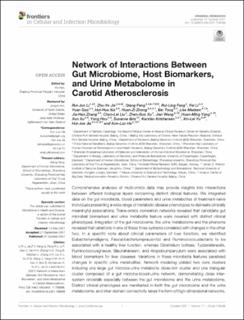Network of Interactions Between Gut Microbiome, Host Biomarkers, and Urine Metabolome in Carotid Atherosclerosis
Li, Rui-Jun; Jie, Zhu-Ye; Feng, Qiang; Fang, Rui-Ling; Li, Fei; Gao, Yuan; Xia, Hui-Hua; Zhong, Huan-Zi; Tong, Bin; Madsen, Lise; Zhang, Jia-Hao; Liu, Chun-Lei; Xu, Zhen-Guo; Wang, Jian; Yang, Huan-Ming; Xu, Xun; Hou, Yong; Brix, Susanne; Kristiansen, Karsten; Yu, Xin-Lei; Jia, Hui-Jue; He, Kun-Lun
Peer reviewed, Journal article
Published version
Permanent lenke
https://hdl.handle.net/11250/2838185Utgivelsesdato
2021Metadata
Vis full innførselSamlinger
- Articles [3011]
- Publikasjoner fra CRIStin [3061]
Originalversjon
Frontiers in Cellular and Infection Microbiology. 2021, 11 . 10.3389/fcimb.2021.708088Sammendrag
Comprehensive analyses of multi-omics data may provide insights into interactions between different biological layers concerning distinct clinical features. We integrated data on the gut microbiota, blood parameters and urine metabolites of treatment-naive individuals presenting a wide range of metabolic disease phenotypes to delineate clinically meaningful associations. Trans-omics correlation networks revealed that candidate gut microbial biomarkers and urine metabolite feature were covaried with distinct clinical phenotypes. Integration of the gut microbiome, the urine metabolome and the phenome revealed that variations in one of these three systems correlated with changes in the other two. In a specific note about clinical parameters of liver function, we identified Eubacteriumeligens, Faecalibacteriumprausnitzii and Ruminococcuslactaris to be associated with a healthy liver function, whereas Clostridium bolteae, Tyzzerellanexills, Ruminococcusgnavus, Blautiahansenii, and Atopobiumparvulum were associated with blood biomarkers for liver diseases. Variations in these microbiota features paralleled changes in specific urine metabolites. Network modeling yielded two core clusters including one large gut microbe-urine metabolite close-knit cluster and one triangular cluster composed of a gut microbe-blood-urine network, demonstrating close inter-system crosstalk especially between the gut microbiome and the urine metabolome. Distinct clinical phenotypes are manifested in both the gut microbiome and the urine metabolome, and inter-domain connectivity takes the form of high-dimensional networks. Such networks may further our understanding of complex biological systems, and may provide a basis for identifying biomarkers for diseases. Deciphering the complexity of human physiology and disease requires a holistic and trans-omics approach integrating multi-layer data sets, including the gut microbiome and profiles of biological fluids. By studying the gut microbiome on carotid atherosclerosis, we identified microbial features associated with clinical parameters, and we observed that groups of urine metabolites correlated with groups of clinical parameters. Combining the three data sets, we revealed correlations of entities across the three systems, suggesting that physiological changes are reflected in each of the omics. Our findings provided insights into the interactive network between the gut microbiome, blood clinical parameters and the urine metabolome concerning physiological variations, and showed the promise of trans-omics study for biomarker discovery.
